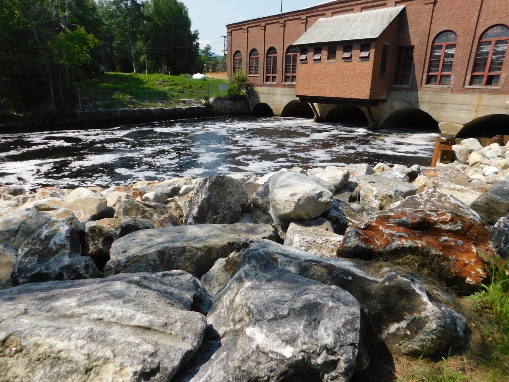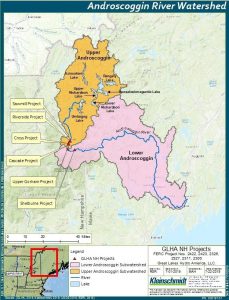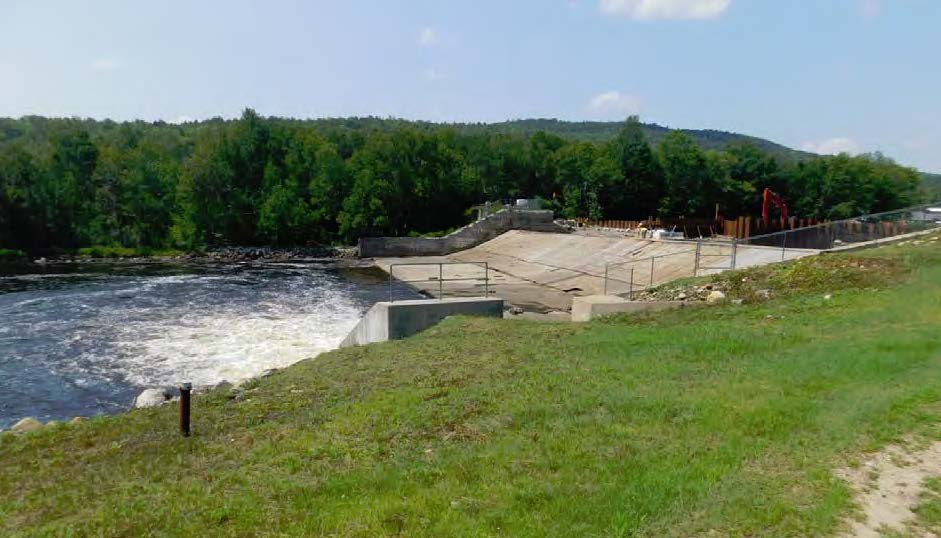LIHI Certificate #175 - Upper Gorham Project, New Hampshire



| Project Name | Upper Gorham |
| LIHI Certificate No. | 175 |
| LIHI Certificate Term | August 31, 2020 – August 30, 2030 |
| Owner | Great Lakes Hydro America, LLC, a subsidiary of Brookfield Renewable Energy Group |
| State | New Hampshire |
| Location | River Mile 133.2 – Androscoggin River |
| Installed Capacity | 4.8 MW |
| Average Annual Generation | 14,859 MWh |
| Facility Type | Run of river |
| FERC No. | Upper Gorham P-2311
Issued in 1994, expires 07/31/2024 |
The Upper Gorham Project is located on the Androscoggin River in Coos County, northern New Hampshire. The Androscoggin River is runs through the states of New Hampshire and Maine. The river joins the Kennebec River at Merrymeeting Bay in Maine before emptying into the Gulf of Maine and subsequently the Atlantic Ocean. The Androscoggin River watershed contains 19 hydroelectric projects located along the 178-mile-long river.
The Project is one of several hydroelectric projects within an 11-mile reach of the Androscoggin River between Berlin and Shelburne, New Hampshire including upstream projects: Cross Power (LIHI #174), Cascade (LIHI #188) and Sawmill (LIHI #173), and two downstream projects: Gorham (LIHI #153), and Shelburne (LIHI #176).
The project includes a dam originally constructed in 1904, power canal, powerhouse, four turbines, and transmission equipment. The dam is 775 feet long with a maximum height of 31feet and is comprised of:
- A 133-foot-long earthen dike with a concrete core wall.
- A 300-foot-long by 18-foot-high rock-filled and timber-crib spillway section with 5-foot-high flashboards.
- A 122-foot-long power canal head gate section, topped with a gatehouse 113 feet long by 16 feet wide, with eight operable and two inoperable stop-log gates, each approximately 7.5 feet wide. Trashracks have 3 1/8-inch clear spacing.
- A 220-foot-long earthen dike with a concrete core wall.
The power canal is 3,350-foot long, 100 feet wide and 18 feet deep. The brick and steel powerhouse contains four horizontal generators and four horizontal Francis turbines for a total combined capacity of 4.8 MW.
The project operates in a quasi-run-of-river mode and impounds a 45-acre reservoir. The impoundment is allowed to fluctuate over a 6-inch range. The project provides a minimum flow of 400 cfs into the 1-mile-long bypass reach throughout trout spawning season (March 1 – June 15) to optimize trout habitat. The rest of the year a 200 cfs minimum flow is provided. This was increased from 50 cfs due to increased demand in angler activity. This flow regime was developed in consultation with US Fish and Wildlife Service (USFWS) and the New Hampshire Department of Environmental Services (NHDES).
Waters within the project reach are designated as Class B, suitable for fishing, primary contact recreation, and water supply after treatment. The project waters are listed as impaired due to prior discharges from several paper mills. Given run-of-river operations, the project is unlikely to adversely impact water quality.
The Androscoggin River is not accessible to diadromous fish species in the project reach. Species such as alewife, blueback herring, striped bass, sea lamprey, and American shad are not present in the area due to downstream natural falls – Lewiston and Rumford Falls. American eel are present in the lower reaches of the Androscoggin River though none have historically reached the upper sections of the river. The project area supports cold-water fishery habitat. New Hampshire Department of Fish and Game annually stocks brook, rainbow, and brown trout upstream of the projects. Resident river species include fallfish, smallmouth bass, white sucker, longnose dace, common shiner, spottail shiner, and yellow perch. Downstream passage can occur by means of spillway flow, low-level gate releases, and power intake flow through the trashracks. The project does not impede the successful completion of resident fish life cycles.
The project lands are limited to the area occupied by project infrastructure. A shoreline protection plan was developed for the project to establish a 250-foot buffer from the shoreline. The plan provides provisions for land uses and planting/vegetation removal standards within the buffer. The plan is consistent with New Hampshire’s Shoreland Protection Act. Further, the project’s run-of-river operations provides protection of the shoreline areas.
Threatened or endangered species potentially present in the project vicinity include the Northern long-eared bat, Canada lynx, eastern small-footed bat, little brown bat, tri-colored bat, bald eagle, Cape May warbler, evening Grobeak, rusty blackbird, wood thrush, wood turtle, American marten, peregrine falcon, and common nighthawk. Plant species include auricled twayblade, mountain sweet-cicely, ovoid spikesedge, parasol sedge, pink shinleaf, purple virgin’s-bower, round-leaved orchid, smooth cliff fern, dwarf blueberry, fragrant wood fern, heart-leaved twayblade, and Hornemann’s willow-herb.
The listed bat species are not likely to be impacted by project operations as there are generally no tree-clearing activities or corridor maintenance activities. Some vegetation removal and maintenance occur to ensure dam safety but said activities adhere to the USFWS 4(d) rule concerning habitat protection for the bat species. Most of the other listed species have been noted in the project vicinity but run-of-river operations and impoundment fluctuation limits mitigate any impact on these species.
The project area does not support any known historic or cultural resources. However, the project operates under a Programmatic Agreement (PA) in consultation with the State Historic Preservation Office. The PA provides provisions detailing annual monitoring and reporting concerning repair and improvement activities conducted as well as any scheduled activities for the upcoming year.
Non-project recreational resources at the project include an Appalachian Mountain Club trail and bicycle trails. Public access is provided free of charge where safe access is available.
Compliance Status
The Certificate includes the following facility-specific condition:
Condition 1: The facility Owner shall provide updates to LIHI on the ongoing status of Project relicensing, including studies, FERC filings, resource agency consultation, prescriptions and recommendations, and agency comments on study results. LIHI reserves the right to modify the Certificate or conditions based on the outcome of the relicensing.
2025: No material changes or compliance issues were identified. The project remains in compliance based on the annual review. For Condition 1, the project provided a status update and links to relicensing documents. FERC issued its final Environmental Assessment on October 7, 2024 and NHDES issued a water quality certification on September 19, 2024.
2024: No material changes or compliance issues were identified. The project remains in compliance based on the annual review. For Condition 1, the project provided a status update and links to relicensing documents. FERC issued its draft Environmental Assessment on May 23, 2024.
2023: No material changes or compliance issues were identified. The project remains in compliance based on the annual review. For Condition 1, the project reported no change in status. The project reported a flow deviation due to equipment malfunction, not considered a FERC violation.
2022: No material changes or compliance issues were identified. The project remains in compliance based on the annual review. For Condition 1, the project reported filing the final FERC relicensing application on August 29, 2022.
2021: There were no reported changes or compliance issues. The project remains in compliance based on the annual review. For Condition 1, the project reported filing of the relicensing initial study report.
2020: Annual reporting for the current Certificate has not yet taken effect.
Certification History
January 1, 2022: The LIHI Certificate term has been extended in accordance with Revision 2.05 of the LIHI 2nd Edition Certification Handbook issued January 1, 2022. Refer to the facility table above for the new term.
November 30, 2020: The decision to certify the Upper Gorham Project became final after the close of the appeals period on November 27, 2020 with no appeals filed. The Certification term is from August 31, 2020 – August 30, 2025.
October 27, 2020:The Low Impact Hydropower Institute (LIHI) preliminarily approved Low Impact Certification for the Sawmill, Cross Power, Upper Gorham, and Shelburne Hydroelectric Projects located on the Androscoggin River in New Hampshire. This decision is preliminary pending the 30-day appeal window. Only those who commented on the initial application during the 60-day comment period are eligible to file an appeal. Such appeal needs to include an explanation as to how the Project does not meet the LIHI criteria. Appeal requests for one or more of these projects can be submitted by email to comments@lowimpacthydro.org with “Androscoggin River-NH Projects” in the subject line, or by mail addressed to the Low Impact Hydropower Institute, 329 Massachusetts Ave, Suite 6, Lexington, MA 02420. All requests will be posted to the website. The applicant will have an opportunity to respond and any response will also be posted. Requests must be received by 5 pm Eastern time on November 27, 2020. The full application and review report are available below. If no appeal requests are received the certification term for each project will be August 31, 2020 through August 30, 2025.
August 13, 2020: The Low Impact Hydropower Institute has received a complete application for Low Impact Certification of the Sawmill, Cross Power, Upper Gorham and Shelburne Hydroelectric Projects located on the Androscoggin River in New Hampshire. LIHI is seeking public comment on this application. Specifically, we are interested in knowing whether you think the Projects meet the LIHI Low Impact Certification Criteria, as revised in the 2nd Edition Handbook. The application can be found below. Comments that are directly tied to specific LIHI criteria (flows, water quality, fish passage, etc.) will be most helpful, but all comments will be considered. Comments may be submitted to the Institute by e-mail at comments@lowimpacthydro.org with “Androscoggin River-NH Project Comments” in the subject line, or by mail addressed to the Low Impact Hydropower Institute, 329 Massachusetts Avenue, Suite 6, Lexington, MA 02420. Comments must be received on or before 5 pm Eastern time on October 12, 2020 to be considered. All comments will be posted to the web site and the applicant will have an opportunity to respond. Any response will also be posted.
